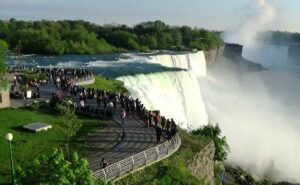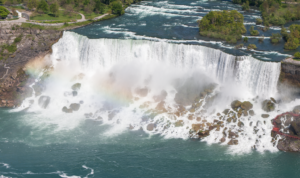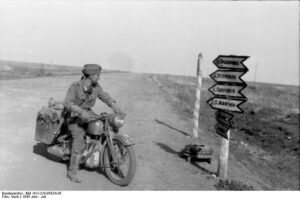Monthly Archives: October 2021

 In the state of New York, just north of Buffalo, the Niagara Falls provide a beautiful border between the United States and Canada. It’s not the first time that water has been part of a border, but not many include a beautiful falls in the mix. Niagara Falls are considered one of the most well-known and breathtaking landmarks in North America. Having seen them for myself, I can attest to that. Tourists have come from all over the world to see this natural wonder as the power of the water has been on display for over 200 years.
In the state of New York, just north of Buffalo, the Niagara Falls provide a beautiful border between the United States and Canada. It’s not the first time that water has been part of a border, but not many include a beautiful falls in the mix. Niagara Falls are considered one of the most well-known and breathtaking landmarks in North America. Having seen them for myself, I can attest to that. Tourists have come from all over the world to see this natural wonder as the power of the water has been on display for over 200 years.
The falls have always been beautiful, but they also have a dark side…and it might have been darker than anyone knew. In 1969, the waters that pounded through the Niagara Falls were stopped before they could get to the area, allowing the bedrock to be exposed and the water to be no more than a little stream. Seeing the Falls like this, for the first time in history, allowed researchers to see a part of this landscape that had been permanently hidden by water. What was found at the bottom of the dried out Falls brought visitors and researchers alike to their knees. Some things were never meant to be found.
The state government and the local community knew that the falls needed some major repairs, if the area was going to continue to have the major tourism business that it had enjoyed for so many years, but they were really not prepared for part of what they found when the water was basically stopped. Niagara Falls is actually made up of three waterfalls, that share a common cliff, making them combined in reality. The American Falls is known for being the most self-destructive one of the three. The water that was going over was eroding it over time. The locals were worried that the America Falls would eventually erode away the cliff, and the tourism trade would end.
What they weren’t really thinking about when the falls were stopped, was what was beneath the falls. Every year, a number of people decide to try some new stunt to gain attention, by going over the falls in a barrel, or some other such vehicle. It’s a crazy idea, and most don’t survive their stunt. That said, one might expect to find lots of bones beneath the falls, when the engineers and workers were standing at the bottom of the Falls, their faces showed total disbelief. “In addition to the massive talus rock and the never before seen geography of the bedrock, there was a far more sinister sight. As the water drew back and dried up so the workers could continue with the plan, they looked down and saw a bones and other remains at their feet. These were not animal remains, either, but human. Everyone at the scene was shocked, but they were also very curious.”
Before them, the engineers found the remains of two individuals, a man and a woman. It was impossible to find out who the remains belonged to, due to the fact that the remains were under water for so long, and the DNA testing and such that we have now were not available then. The whole grisly discovery, remained a mystery, but rumors circulated as to who the people could be. Most assumed that the man might have jumped, but they didn’t think the woman would have. The thing that was even more strange than finding two bodies beneath the falls, was that there were not more bodies of more crazy thrill seekers, because the base of the Falls has had around 5,000 bodies found at its base from 1850 to 2011. Authorities state that between 20 and 40 people a year end their lives right there at the Falls. This statistic is the reason why finding only two bodies in 1969 was so confusing. There should have been more bodies.
Another known, unknown found at the base of the falls were the many coins thrown in as people “made a wish” and tossed in their “lucky” wishing coin. As the engineers looked around, trying to find information on the mystery couple, they also found that there were millions upon millions of coins. While everyone as shocked at both findings, the main mission of the blockage of the water was to fix the falls and get them back on track. Despite the remains and coins that had been found, the point of the mission was to get water going again.
Incredibly, despite all the money and time that was spent on this project, after the talus was dried up in American Falls, the lead engineers made the final decision to leave the talus as is, because they realized that 
 the talus was actually supporting the cliff face behind it. To change it could cause the cliff to cave in. Instead they decided to focus on the project of giving the American Falls the revamp it needed. The team of engineers and construction workers came up with a plan to use bolts, anchors, and cables to stabilize the Falls, so that the falls and tourism could get back on track.
the talus was actually supporting the cliff face behind it. To change it could cause the cliff to cave in. Instead they decided to focus on the project of giving the American Falls the revamp it needed. The team of engineers and construction workers came up with a plan to use bolts, anchors, and cables to stabilize the Falls, so that the falls and tourism could get back on track.
 The German Kradmelder, motorcycle dispatch rider in English, could be used at any time in history, but in this case, they were used during World War II, specifically on the Eastern Front. The Eastern Front of World War II was a theatre of conflict between the European Axis powers against the Soviet Union (USSR), Poland and other Allies, which encompassed Central Europe, Eastern Europe, Northeast Europe (Baltics), and Southeast Europe (Balkans) from June 22, 1941 to May 9, 1945. The Soviet Union called it the Great Patriotic War, but everyone else called it the Eastern Front.
The German Kradmelder, motorcycle dispatch rider in English, could be used at any time in history, but in this case, they were used during World War II, specifically on the Eastern Front. The Eastern Front of World War II was a theatre of conflict between the European Axis powers against the Soviet Union (USSR), Poland and other Allies, which encompassed Central Europe, Eastern Europe, Northeast Europe (Baltics), and Southeast Europe (Balkans) from June 22, 1941 to May 9, 1945. The Soviet Union called it the Great Patriotic War, but everyone else called it the Eastern Front.
Dispatch riders were used by armed forces to get information from headquarters to the military units. They often didn’t have radios, and depending on the message, they might not have trusted the airwaves with some of the top secret messages. The Nazi Regime never really cared about its soldiers or its people, so the Kradmelder were sent out in the heat of summer or the frigid temperatures of winter. They were expendable, and that was all there was to it. Nevertheless, they played a vital role at a time when telecommunications were limited and insecure. They were also used to deliver carrier pigeons. The pigeons were used to send information back to headquarters, concerning the current situations on the front.
This type of dispatch was essential, but riding on an exposed vehicle in the Russian Winter, was brutal, and even deadly sometimes. During the winter the riders had better have protective clothing, or they could freeze to death.  The Kradfahrer (motorcycle rider) might wear a sentry’s fur-lined overcoat, heavy mittens, the fur-lined cap of the reversible winter suit, which is no doubt being worn beneath the overcoat, and a gas-mask for face protection…with the air filter canister removed from the gas-mask. Special extra eyepiece lens were issued for cold weather to prevent fogging by creating an airspace between the two lens.
The Kradfahrer (motorcycle rider) might wear a sentry’s fur-lined overcoat, heavy mittens, the fur-lined cap of the reversible winter suit, which is no doubt being worn beneath the overcoat, and a gas-mask for face protection…with the air filter canister removed from the gas-mask. Special extra eyepiece lens were issued for cold weather to prevent fogging by creating an airspace between the two lens.
In the summer, the German Kradmelder might wear his rubberized coat (Kradmantel) wrapped and buttoned around his legs to keep dirt and dust off his uniform. Personally, I can’t imagine wearing a rubberized coat in the summer simply to keep the dust off of a uniform. The rider would surly be melting from the heat, but the regime would require that the uniform be neat and clean at all times…even if it was soaked in sweat!! During World War II, the German military was the largest employers of motorcycles. On June 22, 1941 Germany launched its Operation Barbarossa, the 3-million-man invasion of the Soviet Union. The Kradmelder served a variety of functions including chauffeur service for officers, delivering dispatches, hot meals, as scouting patrols, as point vehicles taking the brunt of battle, sometimes as specially equipped tank destroyers. As with all motorcyclists, there was a kinship among these soldiers who called themselves “Kradmelder.” They bravely rode exposed without the armor plating of the Panzers Tanks and without the safety of hundreds of foot soldiers beside them. They were moving targets and sniper magnets. They never knew when they would encounter mine fields, artillery fire, and strafing aircraft, but they bravely went, because Hitler’s orders must be carried out…even if they died trying.
 Besides the known enemy, there was another enemy…the Russian weather. As Autumn approached, the roads had turned into nearly impassable bogs, the fields over which the motorcycles traveled turning in to “seas of jelly three feet more deep.” If that weren’t bad enough, Winter brought falling temperatures, often down to -40° Fahrenheit, causing engine oil and exposed soldiers froze solid. The “lucky” German Kradmelder benefited from special heating systems grafted onto their bikes, including foot and hand warmers. Still there were those who did not have these things, and even these things didn’t totally protect the rider. By the end of World War II, many if not most of the motorcycles, along with their riders, simply never returned home.
Besides the known enemy, there was another enemy…the Russian weather. As Autumn approached, the roads had turned into nearly impassable bogs, the fields over which the motorcycles traveled turning in to “seas of jelly three feet more deep.” If that weren’t bad enough, Winter brought falling temperatures, often down to -40° Fahrenheit, causing engine oil and exposed soldiers froze solid. The “lucky” German Kradmelder benefited from special heating systems grafted onto their bikes, including foot and hand warmers. Still there were those who did not have these things, and even these things didn’t totally protect the rider. By the end of World War II, many if not most of the motorcycles, along with their riders, simply never returned home.
 Harvey Ball was a commercial artist from Worcester, Massachusetts. You may not know him, but everyone knows what he created…the smiley face. Harvey Ross Ball was born on July 10, 1921 the third of six children to Ernest G Ball and Christine “Kitty” Ross Ball. Ball’s artistic skills presented early. As a student at Worcester South High School, he decided to become an apprentice to a local sign painter. Later he attended the Worcester Art Museum School, where he studied fine arts, however, it was not in the fine arts that Ball’s fame emerged. He is recognized as the designer of a popular smiley graphic picture, which became an enduring and notable international icon.
Harvey Ball was a commercial artist from Worcester, Massachusetts. You may not know him, but everyone knows what he created…the smiley face. Harvey Ross Ball was born on July 10, 1921 the third of six children to Ernest G Ball and Christine “Kitty” Ross Ball. Ball’s artistic skills presented early. As a student at Worcester South High School, he decided to become an apprentice to a local sign painter. Later he attended the Worcester Art Museum School, where he studied fine arts, however, it was not in the fine arts that Ball’s fame emerged. He is recognized as the designer of a popular smiley graphic picture, which became an enduring and notable international icon.
Ball worked for a local advertising firm after World War II. Then he decided to start his own business, which he called Harvey Ball Advertising, in 1959. He designed the smiley in 1963. The State Mutual Life Assurance Company of Worcester, Massachusetts, now known Hanover Insurance, had purchased Guarantee Mutual Company of Ohio. After the merger, employee morale was pretty  low. The company decided to try to boost morale, so they asked Ball to come up with an image that would help. What he created was a smiley face, with one eye bigger than the other. The creation took Ball ten minutes, and the executives liked it immediately. They paid Ball a mere $45 for his creation.
low. The company decided to try to boost morale, so they asked Ball to come up with an image that would help. What he created was a smiley face, with one eye bigger than the other. The creation took Ball ten minutes, and the executives liked it immediately. They paid Ball a mere $45 for his creation.
The smiley face became part of the company’s friendship campaign, and State Mutual handed out 100 smiley pins to employees. The aim was to get employees to smile while using the phone and doing other tasks. The buttons became popular, with orders being taken in lots of 10,000. More than 50 million smiley face buttons had been sold by 1971, and the smiley has been described as an international icon. As for Ball, well…he never applied for a trademark or copyright of the smiley and that $45 was all he ever got for his trouble. I don’t suppose that did much for his morale. Nevertheless, State Mutual didn’t make any money from the design either. According to Ball’s son, Charles, his father never regretted not registering the copyright. Charles Ball said, “he was not a money-driven guy, he used to say, ‘Hey, I can only eat one steak at a time, drive one car at a time.'”

Ball had a heart for children, and founded the World Smile Foundation in 1999, a non-profit charitable trust that supports children’s causes. Then, he came up with World Smile Day. It was a great idea, I think. How nice it is to celebrate a day dedicated to putting a smile on your face and sharing that great smile with others. The first World Smile Day was celebrated in 1999. It’s been held annually on the first Friday of October since then. After Harvey died in 2001, the “Harvey Ball World Smile Foundation” was created to honor his name and memory. The slogan of the Smile Foundation is “improving this world, one smile at a time.” The Foundation continues to be the official sponsor of World Smile Day each year. We should all consider that slogan.

